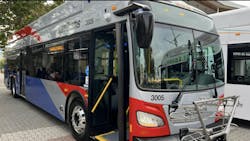SamTrans contracts with Trillium to design and construct permanent hydrogen fueling station to support zero-emissions bus fleet
The San Mateo County Transit District (SamTrans) Board of Directors approved two contracts with Trillium USA Company, LLC to support the development of a permanent hydrogen fueling station at the agency’s North Base Facility in South San Francisco. This contract award supports the agency’s zero-emissions transition plan.
Trillium will design, construct, commission and maintain the new station. The fueling infrastructure will support SamTrans’ growing fleet of hydrogen fuel cell-electric buses (FCEBs), which are gradually replacing end-of-life diesel vehicles.
“Every step we take toward a zero-emission fleet is a step toward cleaner air and healthier communities,” said SamTrans Board Chair Jeff Gee. “This fueling station enables us to scale up responsibly while ensuring reliable service for our riders today and for future generations. The board is committed to positioning SamTrans as a regional leader in clean transportation.”
SamTrans’ Innovative Clean Transit Plan outlines a strategic, phased approach to replace diesel- and gasoline-powered vehicles with zero-emission alternatives. Currently, diesel buses account for about 89 percent of the agency’s greenhouse gas emissions. To address this, SamTrans notes it has committed to replacing 115 diesel buses with FCEBs. Ten FCEBs were approved in 2022 as part of a demonstration project and 108 more were approved in 2023.
SamTrans says the current interim hydrogen fueling setup does not have sufficient capacity to serve the incoming fleet. The new permanent station will ensure SamTrans has the infrastructure needed to power a large-scale FCEB fleet efficiently and safely.
The contract with Trillium includes $17.4 million for design, construction and commissioning of the fueling facility and up to $2.97 million for maintenance services over a potential five-year term. The contractor was selected through a competitive, two-step solicitation process that evaluated qualifications and proposals from multiple national firms.
Design is scheduled to begin shortly this year, with the station expected to be operational in early summer of 2027.
